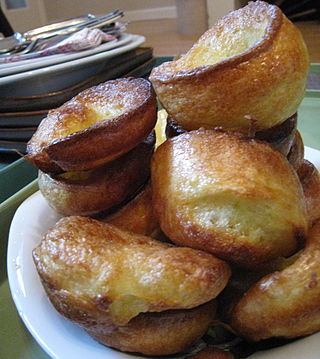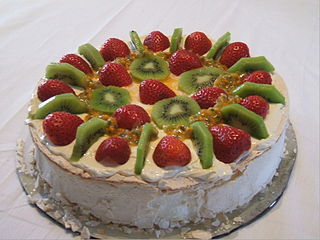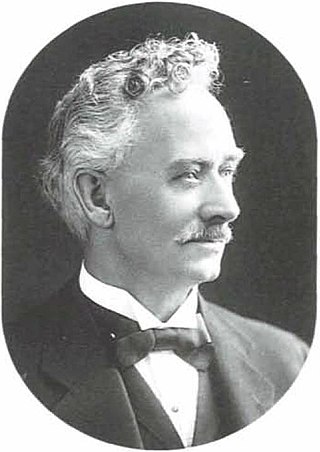
Yorkshire pudding is a baked pudding made from a batter of eggs, flour, and milk or water. A common English side dish, it is a versatile food that can be served in numerous ways depending on its ingredients, size, and the accompanying components of the meal. As a first course, it can be served with onion gravy. For a main course, it may be served with meat and gravy — traditionally roast beef — as part of the traditional Sunday roast, but can also be filled with foods such as bangers and mash to make a meal. Sausages can be added to make toad in the hole. In some parts of England, the Yorkshire pudding can be eaten as a dessert, with a sweet sauce. The 18th-century cookery writer Hannah Glasse was the first to use the term "Yorkshire pudding" in print.

Pavlova is a meringue-based dessert. Originating in either Australia or New Zealand in the early 20th century, it was named after the Russian ballerina Anna Pavlova. Taking the form of a cake-like circular block of baked meringue, pavlova has a crisp crust and soft, light inside. The confection is usually topped with fruit and whipped cream. The name is commonly pronounced pav-LOH-və or pahv-LOH-və, and occasionally closer to the name of the dancer, as PAHV-lə-və.

A pie is a baked dish which is usually made of a pastry dough casing that contains a filling of various sweet or savoury ingredients. Sweet pies may be filled with fruit, nuts, fruit preserves, brown sugar, sweetened vegetables, or with thicker fillings based on eggs and dairy. Savoury pies may be filled with meat, eggs and cheese or a mixture of meat and vegetables.

A pasty or Cornish pasty is a British baked pastry, a variety of which is particularly associated with Cornwall, but has spread all over the British Isles, and elsewhere through the Cornish diaspora. It consists of a filling, typically meat and vegetables, baked in a folded and crimped shortcrust pastry circle.

A scone is a traditional British baked good, popular in the United Kingdom and Ireland. It is usually made of either wheat flour or oatmeal, with baking powder as a leavening agent, and baked on sheet pans. A scone is often slightly sweetened and occasionally glazed with egg wash. The scone is a basic component of the cream tea. It differs from teacakes and other types of sweets that are made with yeast. Scones were chosen as the Republic of Ireland representative for Café Europe during the Austrian presidency of the European Union in 2006, while the United Kingdom chose shortbread.

Pound cake is a type of cake traditionally made with a pound of each of four ingredients: flour, butter, eggs, and sugar. Pound cakes are generally baked in either a loaf pan or a Bundt mold. They are sometimes served either dusted with powdered sugar, lightly glazed, or with a coat of icing.

A chocolate brownie, or simply a brownie, is a chocolate baked dessert bar. Brownies come in a variety of forms and may be either fudgy or cakey, depending on their density. Brownies often, but not always, have a glossy "skin" on their upper crust. They may also include nuts, frosting, chocolate chips, or other ingredients. A variation made with brown sugar and vanilla rather than chocolate in the batter is called a blond brownie or blondie. The brownie was developed in the United States at the end of the 19th century and popularized there during the first half of the 20th century.

Cheesecake is a dessert made with a soft fresh cheese, eggs, and sugar. It may have a crust or base made from crushed cookies, graham crackers, pastry, or sometimes sponge cake. Cheesecake may be baked or unbaked, and is usually served chilled.

Shortcake generally refers to a dessert with a crumbly scone-like texture. There are multiple variations of shortcake, most of which are served with fruit and cream. One of the most popular is strawberry shortcake, which is typically served with whipped cream. Other variations common in the UK are blackberry and clotted cream shortcake and lemon berry shortcake, which is served with lemon curd in place of cream.

Apple crisp is a dessert made with a streusel topping. Ingredients usually include cooked apples, butter, sugar, flour, and cinnamon. The earliest reference to apple crisp in print occurs in 1924. Other similar desserts include apple Brown Betty, apple cobbler, apple crumble, apple pan dowdy, apple pie, and Eve's pudding.
Thomas or Tom Edmonds may refer to:

The Edmonds Cookery Book is a recipe book focusing on traditional New Zealand cuisine. It was first published as The Sure to Rise Cookery Book in 1908 as a marketing tool by baking powder manufacturer Thomas Edmonds, but it is now known as a Kiwi icon.

Bobotie is a South African dish consisting of spiced minced meat baked with an egg-based topping.

American Cookery, by Amelia Simmons, is the first known cookbook written by an American, published in Hartford, Connecticut, in 1796. Until then, the cookbooks printed and used in the Thirteen Colonies were British. Its full title is:
American Cookery, or the art of dressing viands, fish, poultry, and vegetables, and the best modes of making pastes, puffs, pies, tarts, puddings, custards, and preserves, and all kinds of cakes, from the imperial plum to plain cake: Adapted to this country, and all grades of life.

Baklava is a layered pastry dessert made of filo pastry, filled with chopped nuts, and sweetened with syrup or honey. It was one of the most popular sweet pastries of Ottoman cuisine.

An Afghan is a traditional New Zealand biscuit made from flour, butter, cornflakes, sugar and cocoa powder, topped with chocolate icing and a half walnut. The recipe has a high proportion of butter, and relatively low sugar, and no leavening, giving it a soft, dense and rich texture, with crunchiness from the cornflakes, rather than from a high sugar content. The high butter content gives a soft melt-in-the-mouth texture, and the sweetness of the icing offsets the low sugar and the cocoa bitterness.

Nun's puffs are a dessert pastry originally from France, where they were known as pets de nonne. They are now also produced in French Canada, the United States, England, and Spain.

Sponge cake is a light cake made with eggs, flour and sugar, sometimes leavened with baking powder. Some sponge cakes do not contain egg yolks, like angel food cake, but most of them do. Sponge cakes, leavened with beaten eggs, originated during the Renaissance, possibly in Spain. The sponge cake is thought to be one of the first non-yeasted cakes, and the earliest attested sponge cake recipe in English is found in a book by the British poet Gervase Markham, The English Huswife, Containing the Inward and Outward Virtues Which Ought to Be in a Complete Woman (1615). Still, the cake was much more like a cracker: thin and crispy. Sponge cakes became the cake recognised today when bakers started using beaten eggs as a rising agent in the mid-18th century. The Victorian creation of baking powder by British food manufacturer Alfred Bird in 1843 allowed the addition of butter to the traditional sponge recipe, resulting in the creation of the Victoria sponge. Cakes are available in many flavours and have many recipes as well. Sponge cakes have become snack cakes via the Twinkie.

Thomas John Edmonds was a British-born New Zealand businessman and philanthropist, who created and manufactured Edmonds "Sure to Rise" baking powder and the Edmonds Cookery Book. He also financed the construction of several buildings in Christchurch, including gifting the city a band rotunda and clock tower in 1929.





















